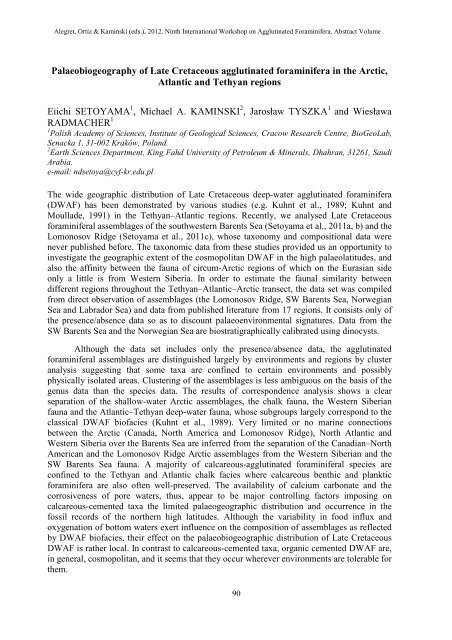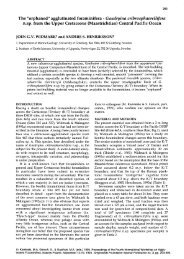Full Text | Download - Grzybowski Foundation - The ...
Full Text | Download - Grzybowski Foundation - The ...
Full Text | Download - Grzybowski Foundation - The ...
You also want an ePaper? Increase the reach of your titles
YUMPU automatically turns print PDFs into web optimized ePapers that Google loves.
Alegret, Ortiz & Kaminski (eds.), 2012. Ninth International Workshop on Agglutinated Foraminifera, Abstract Volume<br />
Palaeobiogeography of Late Cretaceous agglutinated foraminifera in the Arctic,<br />
Atlantic and Tethyan regions<br />
Eiichi SETOYAMA 1 , Michael A. KAMINSKI 2 , Jarosław TYSZKA 1 and Wiesława<br />
RADMACHER 1<br />
1<br />
Polish Academy of Sciences, Institute of Geological Sciences, Cracow Research Centre, BioGeoLab,<br />
Senacka 1, 31-002 Kraków, Poland.<br />
2<br />
Earth Sciences Department, King Fahd University of Petroleum & Minerals, Dhahran, 31261, Saudi<br />
Arabia.<br />
e-mail: ndsetoya@cyf-kr.edu.pl<br />
<strong>The</strong> wide geographic distribution of Late Cretaceous deep-water agglutinated foraminifera<br />
(DWAF) has been demonstrated by various studies (e.g. Kuhnt et al., 1989; Kuhnt and<br />
Moullade, 1991) in the Tethyan–Atlantic regions. Recently, we analysed Late Cretaceous<br />
foraminiferal assemblages of the southwestern Barents Sea (Setoyama et al., 2011a, b) and the<br />
Lomonosov Ridge (Setoyama et al., 2011c), whose taxonomy and compositional data were<br />
never published before. <strong>The</strong> taxonomic data from these studies provided us an opportunity to<br />
investigate the geographic extent of the cosmopolitan DWAF in the high palaeolatitudes, and<br />
also the affinity between the fauna of circum-Arctic regions of which on the Eurasian side<br />
only a little is from Western Siberia. In order to estimate the faunal similarity between<br />
different regions throughout the Tethyan–Atlantic–Arctic transect, the data set was compiled<br />
from direct observation of assemblages (the Lomonosov Ridge, SW Barents Sea, Norwegian<br />
Sea and Labrador Sea) and data from published literature from 17 regions. It consists only of<br />
the presence/absence data so as to discount palaeoenvironmental signatures. Data from the<br />
SW Barents Sea and the Norwegian Sea are biostratigraphically calibrated using dinocysts.<br />
Although the data set includes only the presence/absence data, the agglutinated<br />
foraminiferal assemblages are distinguished largely by environments and regions by cluster<br />
analysis suggesting that some taxa are confined to certain environments and possibly<br />
physically isolated areas. Clustering of the assemblages is less ambiguous on the basis of the<br />
genus data than the species data. <strong>The</strong> results of correspondence analysis shows a clear<br />
separation of the shallow-water Arctic assemblages, the chalk fauna, the Western Siberian<br />
fauna and the Atlantic–Tethyan deep-water fauna, whose subgroups largely correspond to the<br />
classical DWAF biofacies (Kuhnt et al., 1989). Very limited or no marine connections<br />
between the Arctic (Canada, North America and Lomonosov Ridge), North Atlantic and<br />
Western Siberia over the Barents Sea are inferred from the separation of the Canadian–North<br />
American and the Lomonosov Ridge Arctic assemblages from the Western Siberian and the<br />
SW Barents Sea fauna. A majority of calcareous-agglutinated foraminiferal species are<br />
confined to the Tethyan and Atlantic chalk facies where calcareous benthic and planktic<br />
foraminifera are also often well-preserved. <strong>The</strong> availability of calcium carbonate and the<br />
corrosiveness of pore waters, thus, appear to be major controlling factors imposing on<br />
calcareous-cemented taxa the limited palaeogeographic distribution and occurrence in the<br />
fossil records of the northern high latitudes. Although the variability in food influx and<br />
oxygenation of bottom waters exert influence on the composition of assemblages as reflected<br />
by DWAF biofacies, their effect on the palaeobiogeographic distribution of Late Cretaceous<br />
DWAF is rather local. In contrast to calcareous-cemented taxa, organic cemented DWAF are,<br />
in general, cosmopolitan, and it seems that they occur wherever environments are tolerable for<br />
them.<br />
90



